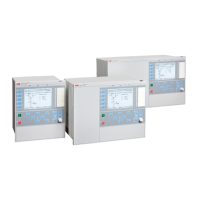active during first fault. No other outputs should be active. Functional outputs
TRIP, all TRLn and TR3P should be active during second fault.
6. Initiate a single-phase-to-earth fault and switch it off immediately when the
trip signal is generated for the corresponding phase. Initiate the second single-
phase-to-earth fault in one of the remaining phases within the time interval,
shorter than tEvolvingFault (default setting 2.0s) and shorter than the dead-
time of SMBRREC, when included in the protection scheme.
Check that the second trip is a three-phase trip and that a three-phase
autoreclosing attempt is given after the three-phase dead time. Functional
outputs TRIP, TRLn and TR1P should be active during first fault. No other
outputs should be active. Functional outputs TRIP, all TRLn and TR3P
should be active during second fault.
7. Initiate a phase-to-phase fault and switch it off immediately when the trip
signal is issued for the corresponding two phases. Initiate a second phase-to-
phase fault between two other phases within the time interval, shorter
thantEvolvingFault (default setting 2.0s).
Check, that the output signals, issued for the first fault, correspond to a two-
trip for included phases. The output signals generated by the second fault
must correspond to the three-phase tripping action.
13.13.1.4 Circuit breaker lockout
The following tests should be carried out when the built-in lockout function is used
in addition to possible other tests, which depends on the complete configuration of
an IED.
1. Check that AutoLock and TripLockout are both set to Off.
2. Activate shortly the set lockout (SETLKOUT) signal in the IED.
3. Check that the circuit breaker lockout (CLLKOUT) signal is set.
4. Activate shortly thereafter, the reset lockout (RSTLKOUT) signal in the IED.
5. Check that the circuit breaker lockout (CLLKOUT) signal is reset.
6. Initiate a three-phase fault.
A three-phase trip should occur and all trip outputs TRL1, TRL2, TRL3
should be activated. Functional outputs TRIP and TR3P should be active at
each fault. The output CLLKOUT should not be set.
7. Activate the automatic lockout function, set AutoLock = On and repeat
Beside the TRIP outputs, CLLKOUT should be set.
8. Reset the lockout signal by shortly thereafter activating the reset lockout
(RSTLKOUT) signal.
9. Activate the trip signal lockout function, set TripLockout = On and repeat.
All trip outputs (TRL1, TRL2, TRL3) and functional outputs TRIP and TR3P
must be active and stay active after each fault, CLLKOUT should be set.
10. Repeat.
All functional outputs should reset.
11. Deactivate the TRIP signal lockout function, set TripLockout = Off and the
automatic lockout function, set AutoLock = Off.
Section 13 1MRK 504 088-UEN C
Verifying settings by secondary injection
200
Installation and commissioning manual

